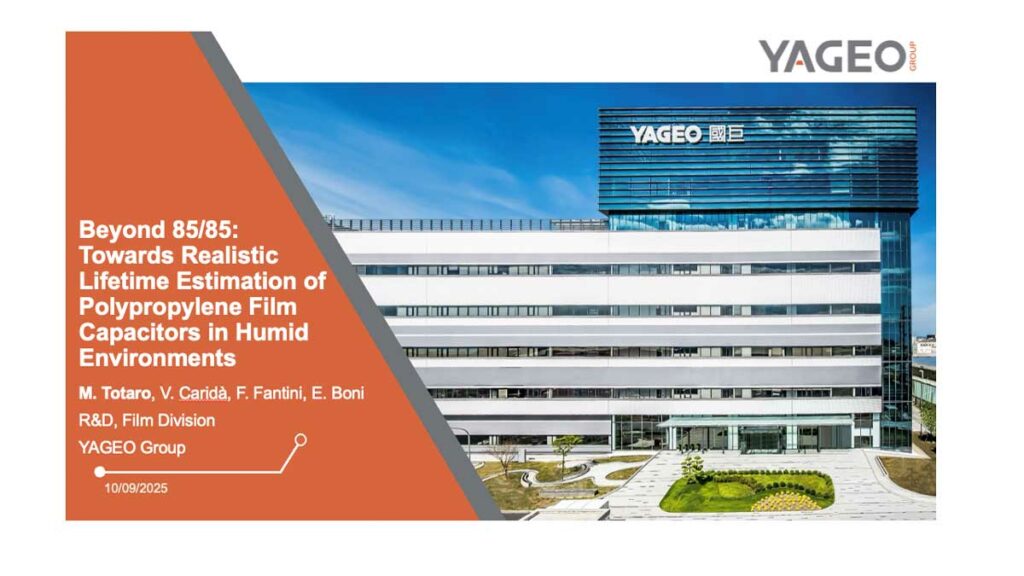The paper “Beyond 85/85: Towards Realistic Lifetime Estimation of Polypropylene Film Capacitors in Humid Environments” was presented by Massimo Totaro, YAGEO KEMET, Sasso Marconi, Italy at the 5th PCNS Passive Components Networking Symposium 9-12th September 2025, Seville, Spain as paper No. 2.8.
This paper was selected by the TPC Technical Program Committee as one of the six top papers for award nomination.
Introduction
Polypropylene film capacitors (PPFCs) are widely used in power electronics, signal processing, and industrial applications due to their excellent electrical performance, thermal stability, and long operational lifetime.
Constructed with biaxially oriented polypropylene films, these capacitors offer low dielectric loss, high insulation resistance, and self-healing capabilities, making them suitable for demanding applications such as DC-link and AC filtering as well as EMI suppression.
Traditional lifetime estimation methods, which often rely on simplified grade-based assumptions and accelerated tests like 85°C/85% RH (THB tests), fail to account for the critical impact of humidity. This oversight can lead to inaccurate predictions and unexpected failures in real-world applications.
Key Points
- Humidity has a profound impact on PPFC degradation, influencing partial discharge, oxidation, and electrochemical corrosion mechanisms.
- Absolute humidity levels define environmental severity, with realistic conditions rarely exceeding 30 g/m³, whereas 85°C/85% RH tests reach 300 g/m³—ten times higher.
- Standard THB tests often misrepresent actual operating conditions, leading to lifetime estimates that can be overly pessimistic or misleading.
- KEMET Lifetime Expectancy Model (K-LEM) integrates realistic environmental conditions, long-term testing, and advanced analysis to provide accurate lifetime predictions.
- K-LEM considers temperature, relative humidity, voltage bias, and harmonic load, enabling confidence levels up to 95% in realistic scenarios.
Extended Summary
The paper highlights the need for accurate lifetime modeling of polypropylene film capacitors, especially in humid environments where moisture ingress can trigger a variety of failure mechanisms. Traditional accelerated testing methods, particularly 85°C/85% RH THB tests, induce extreme electrochemical corrosion that is rarely representative of actual service conditions. Real-world applications, in contrast, experience lower absolute humidity levels (generally below 30 g/m³), where partial discharges, gradual oxidation, and slower electrochemical pathways dominate degradation.
The authors classify environmental conditions based on absolute humidity ranges, noting that moisture effects become meaningful above 15 g/m³ and severe above 20 g/m³. Electrochemical corrosion is most pronounced in environments over 75% RH at elevated temperatures, while oxidation of metallized electrodes accelerates beyond 85°C and can occur even without applied current. Partial discharges, meanwhile, play a significant role in AC applications under lower humidity conditions, especially at the start of component life, causing an initial rapid capacitance drop before stabilization.
The paper critiques the reliance on extreme THB endurance testing. While such tests reveal intrinsic material weaknesses, they fail to capture the subtler degradation trends present in realistic environments where absolute humidity is far lower. Consequently, lifetime predictions solely based on 85/85 data may be overly conservative or misleading, potentially leading to suboptimal component selection.
To address this gap, YAGEO KEMET developed the KEMET Lifetime Expectancy Model (K-LEM). This model incorporates extensive long-term experimental data across a wide range of temperature and humidity conditions, including realistic mission profiles. K-LEM is the first tool of its kind to simultaneously weigh ambient temperature, relative humidity, and applied voltage bias, with the optional inclusion of current harmonic load. The model avoids over-reliance on extreme THB test data, instead emphasizing environmental conditions likely to be encountered in applications such as renewable energy systems, automotive charging infrastructure, and industrial power supplies.
The development process of K-LEM follows a robust workflow: collecting long-term electrical test data across up to 18 environmental conditions, analyzing degradation trends, performing non-linear regressions to define predictive models, and iteratively validating these models with new measurements. The web-based interface allows designers to input specific boundary conditions, combine up to five mission profile segments, and receive a statistically reliable lifetime estimate.
Case studies in the paper illustrate how lifetime ratios between different capacitor grades measured at 85/85 conditions can overstate real-world benefits. For example, a Grade IIIB R53 series capacitor achieves roughly 100% longer life than its Grade IIB R52 counterpart under 85/85 conditions, but in realistic environments, the advantage may decrease to 20–50%, depending on capacitance, dimensions, and operating conditions.
Conclusion
Accurate lifetime estimation for polypropylene film capacitors in humid environments requires moving beyond simplistic grade-based assumptions and extreme THB testing. By focusing on realistic environmental conditions, identifying dominant degradation mechanisms, and leveraging comprehensive experimental databases, K-LEM provides a reliable framework for predicting service life. This approach improves component selection, enhances system reliability, and ensures that designers can make informed decisions supported by data-driven modeling.
